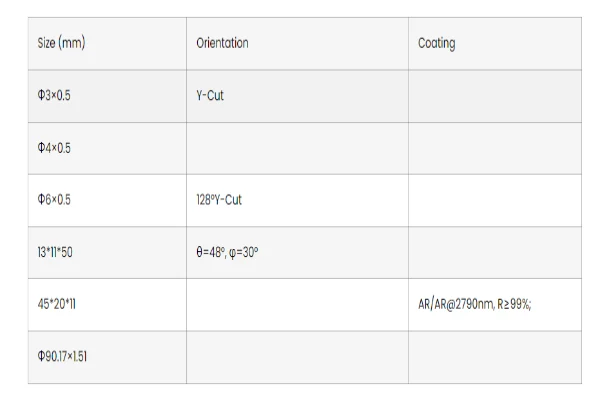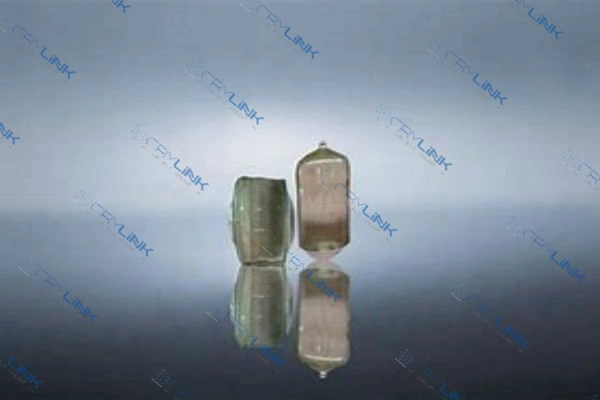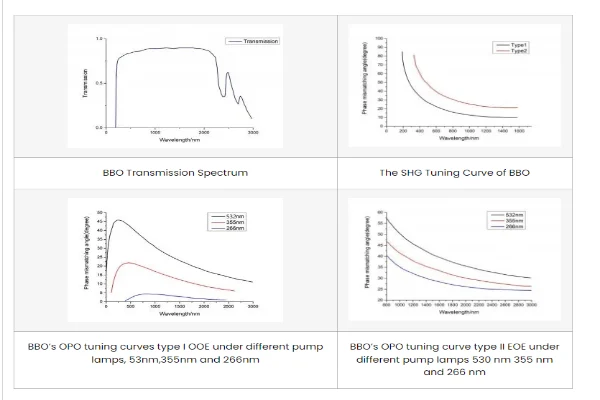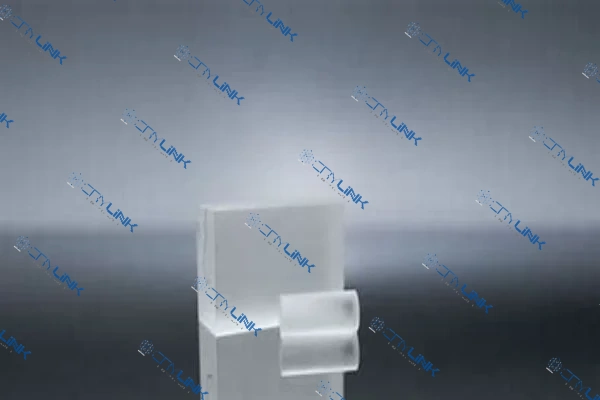Introduction to Pockels Cells and Crystals
Pockels cells are essential components in many optical systems. They leverage the electro-optic effect to modulate the phase, polarization, or intensity of light passing through them. This function is facilitated by the Pockels effect, which describes the alteration of refractive index by an applied electric field.
Different crystals are used to fabricate these cells, each bringing unique properties that make them suitable for various applications. Key crystals include lithium niobate (LiNbO3), potassium dihydrogen phosphate (KDP), and beta barium borate (BBO). The choice of crystal impacts several critical parameters such as electro-optic coefficients, damage thresholds, and response times.
Lithium Niobate (LiNbO3) Pockels Cells: High Electro-Optic Coefficients
Lithium niobate, due to its high electro-optic coefficients, is ideal for systems that demand rapid and precise modulation. The unique crystalline structure of LiNbO3 allows for a more significant interaction between light and the applied electric field, leading to greater modulation depths. This makes LiNbO3 a preferred choice in telecommunication systems and other digital signaling applications, where the rapid modulation of optical signals is paramount for data transfer.

Another appealing aspect of LiNbO3 is its capacity to function at a broad spectrum of wavelengths. This versatile characteristic expands its utility across various optical applications, from visible to infrared light. Therefore, its integration into multi-spectral optical systems, such as advanced imaging and spectroscopy setups, presents compelling opportunities.
However, the susceptibility of LiNbO3 to photorefractive damage is a concern. Photorefractive damage occurs when high-intensity light changes the crystal’s refractive index, potentially affecting the Pockels cell’s performance. This phenomenon is more pronounced in high-power laser applications and can lead to system instability. Despite this, various mitigation strategies, such as operating at elevated temperatures or using doped crystals, can help manage this drawback, thus extending the LiNbO3 Pockels cells’ operational lifetime.
While the high cost of LiNbO3 can be prohibitive, its superior performance justifies the investment in many instances. The overall operational value derived from its high-frequency operation and high extinction ratios often outweighs the initial expense. In applications like high-speed communication and advanced sensing, where performance can’t be compromised, LiNbO3 Pockels cells can deliver unmatched results.
In conclusion, lithium niobate’s unique properties and performance make it a prominent contender in the selection of crystals for Pockels cells. The choice to use LiNbO3 Pockels cells should be driven by a careful assessment of the system’s operational needs, keeping in mind the balance between cost, performance, and longevity.

Potassium Dihydrogen Phosphate (KDP) Pockels Cells: High Damage Thresholds
KDP Pockels cells are designed for environments where durability under high-power laser beams is crucial. The high damage threshold means that KDP can tolerate higher intensities of light before incurring damage, preserving its performance even under intense operating conditions. This characteristic makes KDP an ideal choice for applications in industry, research, and defense where high power lasers are employed.
Although KDP’s electro-optic coefficients may not match those of LiNbO3, it’s important to note that this lower electro-optic coefficient does not significantly hinder its performance in a vast array of applications. KDP is renowned for its effectiveness in Q-switching and mode-locking applications. The lower electro-optic coefficients of KDP result in more stable and less sensitive operation, a feature which is particularly beneficial in systems that may be prone to environmental perturbations.
One crucial advantage that KDP holds over many other crystals is its excellent transparency range. This factor means that KDP can operate effectively across a wide range of light wavelengths, from the ultraviolet through to the far-infrared region of the spectrum. This characteristic not only enhances its versatility in optical applications but also makes it an invaluable asset in multi-wavelength systems.
Furthermore, the cost-effectiveness of KDP cannot be understated. When balancing the needs of an optical system against budget constraints, KDP often emerges as a cost-effective yet high-performing solution. It is, therefore, a widely embraced choice for Pockels cells in a multitude of settings.
In essence, while KDP Pockels cells might not offer the highest electro-optic coefficients, their excellent damage threshold, cost-effectiveness, and impressive transparency range more than compensate for this. These characteristics make them an ideal option in high-power laser applications, as well as situations where versatility and cost are key considerations.

Beta Barium Borate (BBO) Pockels Cells: Fast Response Times
When it comes to ultrafast optical systems requiring nimble responses, Beta Barium Borate (BBO) Pockels cells stand out from the crowd. The fast switching times that BBO Pockels cells offer make them invaluable in applications where every nanosecond counts, such as in laser pulse picking, where the goal is to select and transmit specific pulses from a pulse train.
In these high-speed systems, the rapid response times of BBO Pockels cells can greatly enhance the precision and accuracy of the pulse picking process. The capability to reliably isolate individual pulses from a pulse train makes BBO a standout choice in fields such as laser spectroscopy, microscopy, and high-speed communications.
The wide transparency range of BBO, similar to KDP, enhances its versatility across a broad spectrum of optical applications. BBO’s excellent transparency from the ultraviolet through the visible to the near-infrared region of the spectrum opens up possibilities for its use in a wide array of optical systems. Moreover, the crystal’s non-hygroscopic nature ensures long-term durability and stability, even in challenging environmental conditions.

However, it’s essential to keep in mind that BBO’s damage threshold is lower than that of KDP. While this limits its use in high-power laser applications, it doesn’t overshadow the advantages offered by its swift response times. In particular, for ultrafast applications, such as pulse shaping and mode-locking in femtosecond lasers, where the speed of response is more crucial than high power, BBO Pockels cells truly shine.
In conclusion, while BBO may not be the go-to choice for high-power applications, its unmatched speed and broad transparency range make it a highly attractive option for time-critical applications. The choice of a BBO Pockels cell depends on the precise requirements of the application, particularly where speed and precision are paramount

Selecting the Appropriate Crystal for Specific Applications
Choosing the correct crystal for a Pockels cell goes beyond a simple comparison of properties. It involves a deep understanding of the application’s needs and how the crystal’s characteristics translate into real-world performance.
In Q-switching applications, the ability to handle high-intensity laser pulses is critical. As such, KDP’s high damage threshold makes it a preferred choice. Its durability under high-power laser beams ensures reliable operation, thereby enhancing the overall performance of the Q-switching system. Furthermore, its lower cost and wide transparency range contribute to its appeal, offering a blend of performance and affordability.
For mode-locking applications, the choice between KDP and BBO often hinges on the specific requirements of the system. If the priority is a system that can tolerate high power while delivering ultra-short pulses, KDP’s high damage threshold makes it a viable choice. However, if speed is paramount, BBO, with its fast response times, becomes the preferred option. In either case, the choice should align with the ultimate objective of achieving precise and reliable pulse delivery.
In pulse picking applications, the speed of the Pockels cell is a crucial consideration. The ability to swiftly switch between different states enables the system to select specific pulses from a pulse train accurately. As such, the fast response times of BBO Pockels cells make them well-suited to these applications. Their rapid switching capability ensures high-speed, precise pulse selection, enhancing the efficiency and effectiveness of the pulse picking process.
Finally, for laser beam modulation applications, where the rapid and precise control of the laser beam’s properties is required, LiNbO3 Pockels cells are an excellent choice. The high electro-optic coefficients of LiNbO3 allow for efficient modulation of the beam’s phase and amplitude. This makes it possible to finely tune the laser output, meeting the exacting requirements of sophisticated optical systems.
In summary, the selection of the right Pockels cell involves considering the specific application needs and understanding how different crystals can meet these requirements. Each crystal brings its unique strengths, and the choice should reflect a balance between these strengths and the application’s demands.
The Implications for Optical System Design
The choice of crystal for a Pockels cell significantly impacts the design and performance of an optical system. Carefully considering the system’s requirements and the specific properties of the crystal will help ensure the system performs optimally under varying operating conditions.
For example, if a system requires high-speed modulation, a LiNbO3 Pockels cell may be the best choice. If the system must handle high-intensity laser beams, a KDP Pockels cell might be more appropriate. Conversely, if the system demands fast response times, a BBO Pockels cell should be considered.
Conclusion
Different crystals used in Pockels cells bring unique properties that make them suitable for varying applications. Lithium niobate (LiNbO3) excels in high-speed modulation applications due to its high electro-optic coefficients, while potassium dihydrogen phosphate (KDP) is favored in high-power applications because of its high damage threshold. Beta barium borate (BBO), with its swift response times, is best suited for time-sensitive applications.
The choice between these crystals should be guided by the specific needs of the optical system and the performance characteristics required. By understanding these distinctions, users can make informed choices when selecting the most appropriate Pockels cell for their specific optical system requirements.
Frequently Asked Questions (FAQs)
- 1. What is the role of a Pockels cell in an optical system?
- A Pockels cell modulates the phase, polarization, or intensity of light passing through it, thanks to the electro-optic effect.
- 2. Why are different crystals used in Pockels cells?
- Different crystals, such as lithium niobate, potassium dihydrogen phosphate, and beta barium borate, have unique properties influencing the Pockels cell’s electro-optic coefficients, damage thresholds, and response times.
- 3. How does the choice of crystal affect the performance of a Pockels cell?
- The crystal type determines several performance parameters, such as the speed of modulation, the damage threshold of the cell, and the response time to changes in the electric field.
- 4. Which Pockels cell is best for high-power applications?
- Potassium dihydrogen phosphate (KDP) Pockels cells are often used in high-power applications due to their high damage thresholds.
- 5. What is the advantage of using a beta barium borate (BBO) Pockels cell?
- Beta barium borate (BBO) Pockels cells offer exceptionally fast response times, making them suitable for high-speed pulse picking and other time-sensitive applications.

Frank
Frank graduated from the University of Shanghai for Science and Technology, majoring in optics. As a technical engineer at Crylink Company, he deeply understands crystal materials and laser components.
Related Video(s) with this Article
Related Product(s) with this Article
Related Application(s) with this Article
